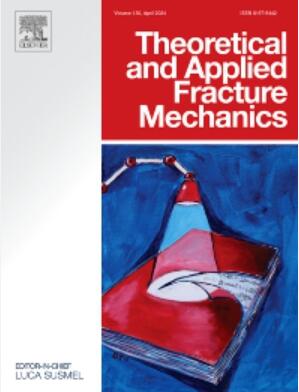Crack initiation behavior in grouted fractured mudstone: Insights from laboratory tests and DEM simulation
IF 5.6
2区 工程技术
Q1 ENGINEERING, MECHANICAL
引用次数: 0
Abstract
Fractured mudstone is prone to structural failure due to weak cementation, low strength, and fissured texture. This study investigated the mechanical behavior and crack evolution of grouted fractured mudstone using uniaxial compression test (UCT), direct shear test (DST), and discrete element method (DEM) simulation. Results indicated that silica-sol grouted specimens under UCT exhibited a higher compressive strength and ductility, with cracks deviating from both sides of the prefabricated fracture, whereas a concentrated and stable shear band was detected in the cement-grouted specimen under the DST, thus improving resistance to the slippage on the interface. Crack evolution was strongly governed by the interaction between fracture inclination and stress state, with a larger inclination angle across the failure zone of the tested specimens. It was revealed from DEM analysis that the rupture and redistribution of strong-force chains during the late loading stage led to the stress concentration and crack penetration. Although an increase in the grouting thickness improved a load-bearing capacity, it also intensified the crack propagation, especially under the UCT. These findings deepen the micromechanical understanding of crack initiation and propagation, providing a theoretical basis for modeling and mitigating failure in grouted fractured rock.
注浆裂缝性泥岩的起裂行为:来自实验室试验和DEM模拟的见解
裂缝性泥岩胶结性弱,强度低,结构有裂隙,易发生结构破坏。采用单轴压缩试验(UCT)、直剪试验(DST)和离散元法(DEM)模拟研究了注浆裂缝性泥岩的力学行为和裂缝演化过程。结果表明:UCT作用下硅溶胶灌浆试件具有较高的抗压强度和延性,裂缝向预制断口两侧偏离,而DST作用下水泥灌浆试件存在集中且稳定的剪切带,增强了界面抗滑移能力。裂纹的演化受断裂倾角和应力状态的共同作用的强烈控制,在试样的破坏区域上有较大的倾角。DEM分析表明,加载后期强力链的断裂和重分布导致应力集中和裂纹贯通。注浆厚度的增加虽然提高了承载力,但也加剧了裂缝的扩展,尤其是在UCT作用下。这些发现加深了对裂缝起裂和扩展的微观力学理解,为注浆裂隙岩石的建模和减轻破坏提供了理论基础。
本文章由计算机程序翻译,如有差异,请以英文原文为准。
求助全文
约1分钟内获得全文
求助全文
来源期刊

Theoretical and Applied Fracture Mechanics
工程技术-工程:机械
CiteScore
8.40
自引率
18.90%
发文量
435
审稿时长
37 days
期刊介绍:
Theoretical and Applied Fracture Mechanics'' aims & scopes have been re-designed to cover both the theoretical, applied, and numerical aspects associated with those cracking related phenomena taking place, at a micro-, meso-, and macroscopic level, in materials/components/structures of any kind.
The journal aims to cover the cracking/mechanical behaviour of materials/components/structures in those situations involving both time-independent and time-dependent system of external forces/moments (such as, for instance, quasi-static, impulsive, impact, blasting, creep, contact, and fatigue loading). Since, under the above circumstances, the mechanical behaviour of cracked materials/components/structures is also affected by the environmental conditions, the journal would consider also those theoretical/experimental research works investigating the effect of external variables such as, for instance, the effect of corrosive environments as well as of high/low-temperature.
 求助内容:
求助内容: 应助结果提醒方式:
应助结果提醒方式:


